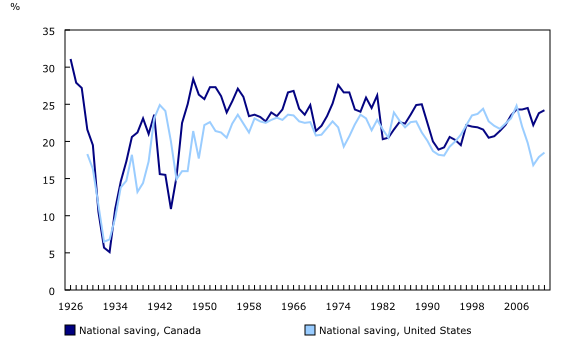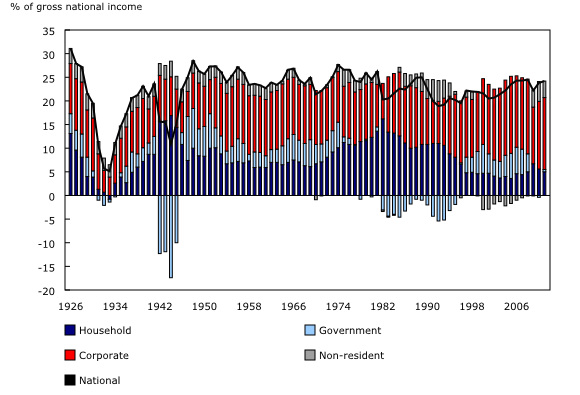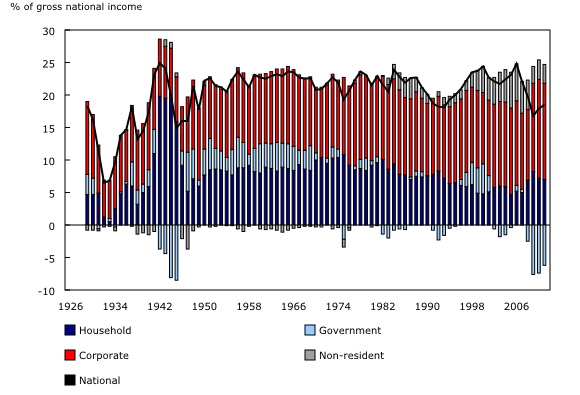Study: National saving in Canada and the United States, 1926 to 2011
Archived Content
Information identified as archived is provided for reference, research or recordkeeping purposes. It is not subject to the Government of Canada Web Standards and has not been altered or updated since it was archived. Please "contact us" to request a format other than those available.
Released: 2014-06-26
Saving rates are defined as the ratio of gross saving to gross income. National saving rates, in turn, are the sum of all saving in the economy. A new study tracked savings rate data in Canada and the United States from 1926 to 2011 and found both commonalities and differences.
The study shows that national saving rates fell significantly in both countries during the Great Depression and then climbed steeply leading up to the Second World War.
Following the war, gross national saving rates in Canada averaged about 25% for the period from 1950 to 1971, above the 22% average rate for that period in the United States. The Canadian saving rate declined during the 1970s and 1980s, and then stabilized around an average of 22% for the 1990-to-2011 period, not significantly different from the saving rate in the United States.
Differences among the sectors
The study also found that the individual components of the national saving rate, specifically, the household, business, and government sectors, were less stable than the national saving rates in both Canada and the United States. Saving rates in the individual sectors often move in opposite directions, which provides stability for national saving rates overall. For example, household and corporate saving rates moved in opposite directions from 1950 to 2011. Changes in household and corporate saving were also offset by changes in the government sector over the same period.
Household saving rates evolved differently in Canada and the United States. In neither country is the household saving rate a good predictor of the national saving rate. For the post-war period in Canada, the household saving rate increased through the 1970s, peaked in the early 1980s, and declined through the 1990s, before posting a modest increase in the latter half of the 2000s. In the United States, the household saving rate rose modestly between the 1950s and the 1970s, after which it began an extended period of decline until the late 2000s.
In Canada, the changes in household saving were partially offset by changes in government saving and corporate saving. For example, as household saving rates declined through the 1990s, so too did government deficits. The observed pattern of negative correlations between households and government across business cycles holds for the United States as well. However, during the extended period of declining household saving rates in the United States, the decrease in household saving was offset by increases in non-resident saving (borrowing from abroad) and increases in corporate saving.
Corporate saving rates move opposite to households and governments
Over the 1970-to-2008 period, corporate saving tended to increase as the contribution to national saving from households and governments declined. In Canada, corporations contributed more than 14 percentage points to national saving in the 2000s compared with an average of 11 percentage points during the 1990s. In the United States, the share of saving coming from the corporate sector also increased over time.
Non-resident saving also plays a role
The contribution of non-residents to saving in Canada was generally positive over the 1950-to-2011 period. Non-resident saving is positive when a nation borrows abroad—that is when deficits are generated on the current account balance and when net reinvested earnings on foreign investment are positive.
However, Canada became a lender to the rest of the world in the 2000s. This coincided with a period when the corporate saving rate reached its highest level on record. In contrast, the non-resident saving rate in the United States began rising in the early 1970s, as the United States moved from lending abroad to borrowing from abroad. The contribution of non-residents to national saving in the United States increased steadily until the end of the period.
Note to readers
This study measures the national saving rate as the sum of gross saving from four institutional sectors: the household sector, the corporate sector, the government sector and the non-resident sector. To measure the saving rate, national saving is divided by gross national income (GNI). This measure was formerly referred to as gross national product.
Sectoral saving rates are defined as the gross saving in that sector divided by total GNI. This approach means that the sum of the gross saving rates of the sectors is equivalent to the aggregate national saving rate, and each sector's gross saving rate is equal to its contribution to the national gross saving rate.
It is important to note, however, that the household gross saving rate discussed in this study differs from the more commonly reported household net saving rate. The latter is measured as the net saving of the household sector divided by household disposable income. Empirically, the household net saving rate and the measure of the household gross saving rate examined in this article follow similar patterns through time, but their levels differ.
The research paper "National Saving in Canada and the United States, 1926 to 2011," part of the Economic Analysis Research Paper Series (Catalogue number11F0027M), is now available from the Browse by key resource module of our website under Publications.
Similar studies are also available in the Update on Economic Analysis module of our website.
Contact information
For more information, contact us (toll-free 1-800-263-1136; 514-283-8300; infostats@statcan.gc.ca).
To enquire about the concepts, methods or data quality of this release, contact Ryan Macdonald (613-951-5687; ryan.macdonald@statcan.gc.ca), Economic Analysis Division.
- Date modified:




